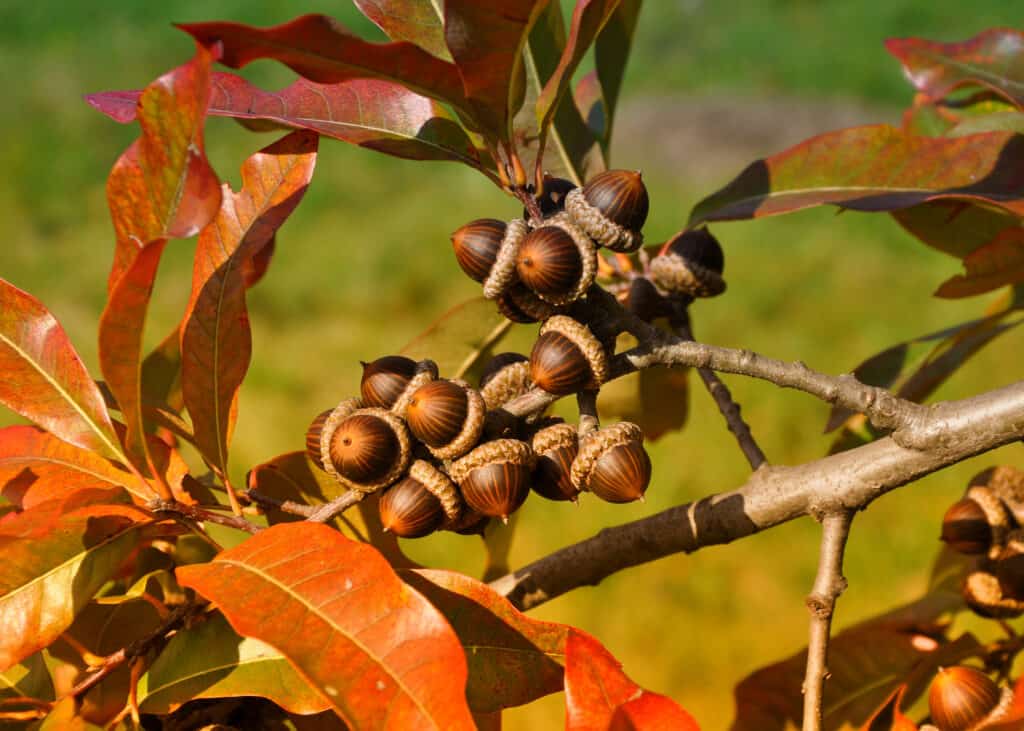There are over 500 species of oak trees. As such, it’s no surprise that they’re often mistaken for one another.
While the laurel oak and live oak look similar, there are some key differences in how they grow and their care needs. Here’s how to tell the difference between the two so you can make the right choice for your property.
Laurel Oak vs. Live Oak: Key Differences
Laurel oaks are semi-evergreen and keep their leaves until late winter. Live oaks are true evergreens and don’t drop their leaves.
It’s important to note that the term live oak is often used as an umbrella term for any evergreen oak in the Southern states, though there are many subspecies with minor variations in leaf and bark characteristics. When speaking colloquially of a specific species, live oak generally refers to the Southern live oak.
Laurel Oak vs. Live Oak: Classification
Laurel oaks and live oaks are related through the genus Quercus, which refers to all oak trees.
Both the laurel oak and live oak are also members of the subgenus Quercus (New World Oaks) to differentiate them from the subgenus Cerris (Old World Oaks). In other words, these oaks are native to North America rather than Europe and Asia.

©Serge Skiba/Shutterstock.com
Laurel Oak vs. Live Oak: Origin
Both laurel oaks and live oaks are both native to North America, specifically covering the Southern states. Laurel oaks extend farther west to California while live oaks are more plentiful in the east. It’s possible the laurel oaks growing on the West coast were transplanted by humans, and are not naturally occurring.
Laurel Oak vs. Live Oak: Description
Laurel oaks are taller than live oaks, growing 65-80 feet tall, with some growing up to 130 feet. Their leaves are distinctive with a narrow, tapered, oval shape and raised veins. When found in a deep forest, the bark is often a dark brown with a smooth texture. In some areas, lichen covers the laurel trunks, making them appear lighter and gray-silver.

©Michael O’Keene/Shutterstock.com
Live oaks can grow 50-80 feet tall, but grow shorter and wider in some regions. They have rougher trunks with deep fissures in the bark. Their leaves are oblong with a shiny, waxy deep green top that looks and feels like leather. The bottom of the leaves is a softer green.
Laurel oaks grow faster than live oaks, but live oaks have a longer. While a healthy laurel oak can live up to 150 years, live oaks can live far longer.
Both laurel oaks and live oaks produce near-identical acorns. However, laurel oaks fruit in the late fall or early winter while live oaks fruit in the late summer or early fall.

©carpathian/Shutterstock.com
Laurel oaks and live oaks are difficult to tell apart in urban settings due to pruning habits and growth restrictions. Hurricanes and extreme weather can also affect the trees’ leaf-shedding patterns, making them appear deciduous.
Laurel Oak vs. Live Oak: Uses
Laurel oak is a favored ornamental tree. Its low-quality wood is not suitable for lumber, though it’s frequently used for pulpwood products. Laurels are a nice addition to a country yard or garden that will attract herbivorous wildlife.
Live oaks are robust and sturdy. They were used historically in shipbuilding and cooperage. Live oaks were used to build the USS Constitution (a.k.a. Old Ironsides), a US Navy frigate named by President Washington and used in the battle of 1812. These days, live oak is used for building furniture, cabinets, flooring, and trim.

©iStock.com/Sunshower Shots
Laurel Oak vs. Live Oak: Growth Tips
Plant laurel oak in USDA Zones 7-10 in an area with full sun or partial shade. Allow plenty of room, placing the tree at least 15 feet from your house. Laurel oak is tolerant to diverse soils, but thrives in loamy or clay-rich soil. Water bi-weekly for the first few months until established, skipping weeks with heavy rainfall.
Plant a live oak in USDA Zones 6-10 during its dormant period (late winter) in an area with full sun. Allow plenty of room, placing the live oak at least 15 feet from your house. Plant with bone meal and add mulch. Water weekly for the first season until established, skipping weeks with heavy rainfall.
Up Next:
- Live Oak vs. Water Oak: What’s the Difference?
- Discover The 20+ Different Types of Oak Trees
- Skip Laurel vs Cherry Laurel: Is There a Difference?
Sources:
- https://ift.tt/islXYN0
- https://ift.tt/3mNKshC
- https://ift.tt/qNL1g2i
The post Laurel Oak vs. Live Oak appeared first on AZ Animals.
from Animal News, Facts, Rankings, and More! - AZ Animals https://ift.tt/P0BiAbI